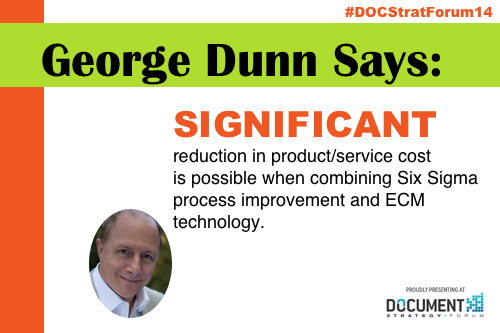
Applying Six Sigma process improvement methodology and electronic content management (ECM) technology to documents currently stored in email, shared network drives and paper can result in a significant reduction of product/service cost and issues.
What is Six Sigma?
Six Sigma is based upon work by Shewhart and Deming (post WWII Japan), further developed by Motorola in 1980s and made popular by Jack Welsh at GE in 1995. Six Sigma focuses on improving quality of process by identification and removal of the cause of:
- process defects and
- reduction of process variability
Six Sigma uses statistical methods and goals towards 99.99966% of the products/services manufactured to be statistically free of defects.
What is ECM?
ECM consists of software module(s), which provide storage, security, view and output of electronic content (documents, text, video, voice) and related indexes. Content stored in ECM include those captured from scanners, email, shared network drives and created using native applications, such as word processing and spreadsheet. As the documents stored in ECM are viewed, analyzed or as appropriately modified, additional indexes are added, such as version number and last view date. Annotations, sticky notes or signatures may be attached/authenticated. Some ECM products include electronic records management (ERM) modules. ERM provides retention and disposition (deletion) rules for documents stored in the ECM system, based upon attributes such as record series, close date, retention period and legal holds.
Checklist
Using the Six Sigma “Deming Plan-Do-Check-Act Cycle” as a framework, we can determine how to improve processes related to documents stored in email, shared network drives and paper and determine the ROI for money spent on ECM/ERM technology.
Step 1: Define the document management problem.
- Internally, do employees have a difficult time finding documents? Does the corporate records manager have control over documents stored electronically, and/or is general legal counsel frustrated at the cost of e-discovery?
- Is the cost of your product/service higher than the customer wants to pay (voice of the customer)? How much? Do customers require faster production or response time? How fast?
What is the project goal necessary to overcome the above problems? For example, assess the cost, quality, service, regulatory and e-discovery benefits of implementing Six Sigma process improvement and ECM/ERM.
Step 2: What are the key measurement(s) of the current process? What defects exist for email, shared network drives and paper?
- What percentage of emails are deleted upon personal preference of the user, not copied to the shared network drive or deleted prematurely by IT?
- For shared network drives, what percentage of documents stored on these drives are not recognizable (proper document title) by the document “save as” description, do not have proper versioning or do not have proper security to prevent unauthorized access? What is the percent of the document search that is not accurate? What percentage of documents are duplicated in paper, email and shared drives?
- For e-discovery, what percentage of documents are discoverable that would not have been if documents “were disposed of at the time specified in the organization's approved records schedule and previous to any legal hold requirements?”
- For disposition, what percentage of electronically stored documents are not disposed of in accordance with the organization's records schedule?
Calculate the cost (profit, quality, service, lost customers) to the organization resulting from the above defects?
Step 3: Analyze data to understand and verify cause–effect relationships. Seek out root causes of defect. For example:
- All documents are not stored in one place, accessible electronically, indexed correctly, version controlled, secured and disposed of in accordance with approved records schedule.
- Incorrect index information is provided.
- Unnecessary “non-value” steps are occurring.
Step 4: Improve/optimize current process.
- Determine how the quality of the process can be improved through identification and removal of the cause of document management process defects and reduction of process variability through Six Sigma and ECM/ERM.
- Calculate the return on investment.
At the DOCUMENT Strategy Forum, I will provide specific case study details on how Six Sigma and ECM/ERM can reduce an organization's product/service cost by 10% and provide a significant ROI.
Step 5: Control future state.
Make sure future state deviations are corrected before they result in defects. On-going analysis to identify, understand and improve defects resulting from new: process, file formats, retention/disposition rules, software upgrades and other items.
Mr. Dunn, president of CRE8 Independent Consultants, will be presenting on Tuesday, May 13, 2014 at the DOCUMENT Strategy Forum. Don't miss his Power Session P204/P205 “Taking Automation a Step Further: Process Innovation & Advanced Paperless Technology.” For more information, visit www.DOCUMENTstrategyForum.com.
*As planning for Six Sigma and ECM technology must to be tailored to the specific need of each organization, the information provided here should be treated as an introduction only and, as such, without a direct consultation of requirements, CRE8 cannot assume responsibility for the use, implementation or results of information provided. This article contains CRE8’s understanding of Six Sigma and ECM/ERM. As there are many different definitions and books espousing Six Sigma methodology and as ECM/ERM technology abilities can change, the reader should conduct research to learn more about the specifics of the methodology and technology.














